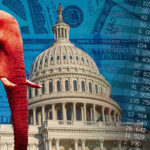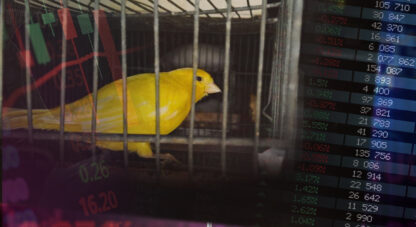For the Week:
The S&P500 dropped 3.8% (down 1.5% y-t-d), and the Dow fell 4.4% (down 1.8%). The Utilities declined 1.4% (up 1.4%). The Banks lost 2.3% (down 8.1%), and the Broker/Dealers fell 2.8% (down 3.1%). The Transports declined 2.0% (down 2.3%). The S&P 400 Midcaps dropped 2.2% (down 4.0%), and the small cap Russell 2000 fell 2.5% (down 3.0%). The Nasdaq100 sank 4.9% (up 2.0%). The Semiconductors dropped 3.4% (down 5.9%). The Biotechs declined 1.3% (up 7.6%). With bullion little changed, the HUI gold index slipped 0.5% (down 23.1%).
Three-month Treasury bill rates ended the week at 2.35%. Two-year government yields added a basis point to 2.81% (up 92bps y-t-d). Five-year T-note yields slipped a basis point to 2.87% (up 66bps). Ten-year Treasury yields declined two bps to 3.04% (up 63bps). Long bond yields dipped two bps to 3.30% (up 56bps). Benchmark Fannie Mae MBS yields added two bps to 3.94% (up 95bps).
Greek 10-year yields slipped one basis point to 4.54% (up 46bps y-t-d). Ten-year Portuguese yields declined three bps to 1.94% (unchanged). Italian 10-year yields dropped eight bps to 3.41% (up 139bps). Spain’s 10-year yields were unchanged at 1.63% (up 6bps). German bund yields declined three bps to 0.34% (down 9bps). French yields fell four bps to 0.72% (down 6bps). The French to German 10-year bond spread narrowed one to 38 bps. U.K. 10-year gilt yields declined three bps to 1.48% (up 19bps). U.K.’s FTSE equities index declined 0.9% (down 9.6%).
Japan’s Nikkei 225 equities index slipped 0.2% (down 4.9% y-t-d). Japanese 10-year “JGB” yields declined three bps to 0.10% (up 5bps). France’s CAC40 fell 1.6% (down 6.9%). The German DAX equities index declined 1.3% (down 13.4%). Spain’s IBEX 35 equities index fell 1.5% (down 11.2%). Italy’s FTSE MIB index declined 0.9% (down 14.4%). EM equities were lower. Brazil’s Bovespa index dropped 2.6% (up 12.9%), and Mexico’s Bolsa sank 2.8% (down 16.6%). South Korea’s Kospi index declined 1.7% (down 16.6%). India’s Sensex equities index fell 1.3% (up 2.7%). China’s Shanghai Exchange sank 3.7% (down 22%). Turkey’s Borsa Istanbul National 100 index slipped 0.7% (down 19.4%). Russia’s MICEX equities index fell 1.3% (up 11.1%).
Investment-grade bond funds saw inflows of $287 million, while junk bond funds posted outflows of $2.191 billion (from Lipper).
Federal Reserve Credit last week sank $34.9bn to $4.070 TN. Over the past year, Fed Credit contracted $340bn, or 7.7%. Fed Credit inflated $1.259 TN, or 45%, over the past 315 weeks. Elsewhere, Fed holdings for foreign owners of Treasury, Agency Debt dropped $15.0bn last week to $3.405 TN. “Custody holdings” were up $32.8bn y-o-y, or 1.0%.
M2 (narrow) “money” supply gained $4.0bn last week to $14.279 TN. “Narrow money” gained $501bn, or 3.6%, over the past year. For the week, Currency increased $1.5bn. Total Checkable Deposits declined $10.3bn, while Savings Deposits added $1.3bn. Small Time Deposits rose $6.1bn. Retail Money Funds gained $5.5bn.
Total money market fund assets jumped $17.8bn to $2.938 TN – the high going all the way back to May 2010. Money Funds gained $199bn y-o-y, or 7.3%.
Total Commercial Paper gained $4.4bn to $1.089 TN. CP rose $60.0bn y-o-y, or 5.8%.
Currency Watch:
November 19 – Bloomberg (Katherine Greifeld): “The yuan could face more weakness and not only because of rising trade tensions between China and the U.S., or currency manipulation. For the first time in at least a decade, one-year Treasuries yield more than short-term Chinese debt, and BMO Capital Markets says that spells trouble for China’s currency. A relentless slump in 12-month Treasury bills has pushed the yield to 2.66%, edging above the 2.56% yield on similar-maturity Chinese securities for the first time since at least 2008. At the start of 2018, the Chinese securities yielded about 200 bps more than the T-bills. Diverging monetary policy on the part of the Federal Reserve and the People’s Bank of China should keep that gap growing, leaving the yuan vulnerable, according to BMO.”
The U.S. dollar index increased 0.5% to 96.944 (up 5.2% y-t-d). For the week on the upside, the South African rand increased 1.0% and the Swiss franc gained 0.3%. For the week on the downside, the Brazilian real declined 2.3%, the Norwegian krone 1.8%, the New Zealand dollar 1.4%, the Australian dollar 1.4%, the Mexican peso 1.2%, the Swedish krona 1.0%, the euro 0.7%, the Canadian dollar 0.7%, the South Korean won 0.2%, the British pound 0.2%, the Singapore dollar 0.1% and the Japanese yen 0.1%. The Chinese renminbi declined 0.15% versus the dollar this week (down 6.36% y-t-d).
Commodities Watch:
November 23 – CNBC (Sam Meredith and Tom DiChristopher): “Oil prices fell on Friday to their lowest levels in more than a year, deepening a rapid seven-week sell-off that has plunged crude futures deep into a bear market. Friday’s declines further ramp up the pressure on OPEC ahead of a much-anticipated meeting between the influential oil cartel and its allies in Vienna on Dec. 6… So far, the prospect of the Middle East-dominated group orchestrating a fresh round of supply cuts has done little to prop up crude futures. U.S. benchmark West Texas Intermediate crude ended Friday’s session down $4.21, or 7.7%, at $50.42.”
November 23 – Bloomberg (Marvin G. Perez): “Tumbling oil prices are leading the Bloomberg Commodity Index to its lowest level since late June of last year. The gauge is now down almost 7% for 2018.”
The Goldman Sachs Commodities Index fell 2.4% (down 4.6% y-t-d). Spot Gold was little changed at $1,223 (down 6.1%). Silver was about unchanged at $14.367 (down 16.2%). Crude sank $6.06 to $50.40 (down 17%). Gasoline fell 11.8% (down 23%), and Natural Gas dropped 5.5% (up 37%). Copper declined 0.9% (down 16%). Wheat fell 1.6% (up 19%). Corn lost 1.4% (up 6%).
Market Dislocation Watch:
November 19 – Bloomberg (Tasos Vossos): “Credit markets are set for the worst year since the global financial crisis as investors abandon hope of a late-2018 rally. High-yield and investment-grade notes are headed for losses in both euros and dollars, the first time all four asset classes have posted negative total returns since 2008… It’s been a exceptionally volatile month, with headlines on companies… triggering the biggest weekly jump in euro high-yield spreads in almost seven years, while dollar investment-grade spreads are at a two-year high amid a sell-off triggered by General Electric Co.’s woes… The credit rout, which extends to sterling notes and high-coupon contingent-capital bank bonds, has particularly hit dollar investors as they have suffered wider spreads and higher Treasury yields. U.S. investment-grade bonds have posted negative total returns of 3.71% in 2018, compared to a 2.9% loss in sterling and 1.2% in euro, according to Bloomberg Barclays indexes.”
November 20 – Bloomberg (Jeremy Hill and Natalya Doris): “The cracks in the credit market are widening as investors face their fears about the mountains of debt weighing on corporate America. If pressure began building last month, things blew up last week: High-grade bond spreads widened the most in nearly two years, premiums paid for junk bonds jumped the most in almost two years, and the prices of leveraged loans sank to the lowest since 2016. As a result, companies selling bonds have paid a price. ‘It’s going to be a pretty sloppy market through year-end,’ said Scott Kimball, a portfolio manager at BMO Global Asset Management… ‘There’s no data point we think will change directions between now and the end of the year.’”
November 20 – Bloomberg (Charles Stein): “Investors pulled more money out of stock and bond funds in October than in any month in more than three years. Mutual and exchange-traded funds had net redemptions of $29.1 billion last month, the biggest outflows since August 2015… The data exclude money-market funds.”
November 19 – Wall Street Journal (Jon Sindreu): “The world is short of dollars again. Emerging markets could be the chief victims this time round. Signs of a global dollar shortage abated this year, only to resurface in mid-September. Investors and companies outside of the U.S. rely on the currency as the ultimate source of liquidity. Many were hurt by bouts of dollar scarcity after the 2008 financial crash, during the euro crisis, and even in 2016. The shortage is usually most acute around quarter and year ends, because banks report their books to regulators and try to make their exposure look smaller relative to their capital. Banks now know they need to get their dollars well before the dreaded year-end deadline, so the potential for damage now is likely lower than in the past.”
November 20 – Bloomberg (Carolynn Look and Tom Beardsworth): “Current and former European Central Bank officials are warning about the consequences for Italian bonds of ending the institution’s asset-purchase program. …Governing Council member Ewald Nowotny noted that the central bank, under the ECB’s guidance, is the largest buyer of the country’s debt. He said that raises the question of who will purchase the roughly 275 billion euros ($310bn) of government securities Italy is expected to issue next year. Former Irish central bank governor Patrick Honohan also said that the ECB’s plan to stop expanding its balance sheet after this year could put Italy in a weak spot. ‘When this support is removed, the yield on Italian government bonds will be much more vulnerable,’ Honohan said…”
November 20 – Wall Street Journal (James Mackintosh): “Holders of General Electric GE bonds are preparing for one of the world’s biggest borrowers to be downgraded to junk. To get a sense of what that might do to the markets, take a look back to the turmoil caused by the 2005 downgrades of General Motors and Ford-but worry that this time it might be worse because so many companies have been on a debt binge. Back in 2005 it was easier for the overall market to shrug off the troubles in credit, because corporate debt… was under control, with the boom in borrowing linked instead to mortgages. This time round companies have been the big borrowers, and the riskiest parts of the debt markets are stoking concern among policy makers. GE’s financial troubles are self-inflicted… Yet, it is the world’s sixth-most indebted nonfinancial company, behind Volkswagen , Toyota, AT&T, SoftBank, Ford and Daimler. And it has more traded debt outstanding than any of them, totaling $122 billion… It is big enough to shake the entire market.”
November 21 – Bloomberg (Yalman Onaran and Michael J. Moore): “When it comes to U.S. banks’ lending risk, it doesn’t get much bigger than General Electric Co. The five biggest Wall Street firms have committed to lending at least $3.5 billion each to the industrial giant facing concerns about the sustainability of its debt. GE has almost $41 billion in credit lines it can draw from… If fully tapped, the two main credit facilities would rank as the largest loans to any U.S. company that go beyond next year… GE had used only about $2 billion of the available credit by the end of the third quarter…”
Trump Administration Watch:
November 23 – Bloomberg: “U.S. President Donald Trump and Chinese leader Xi Jinping have indicated they’re both ready for a highly anticipated meeting at the Group of 20 summit in Argentina next week. The world’s biggest economies have been engaged in an escalating trade war that is starting to have a greater impact on financial markets and global growth. On Thursday, Trump told reporters that China wants to make a deal ‘very badly’ after his administration placed tariffs on about $200 billion worth of Chinese goods. China ‘wants to make a deal and we’re very happy with that,’ Trump said. ‘I’m very prepared, I’ve been preparing for it all my life.’”
November 20 – Financial Times (James Politi): “The Trump administration said China had ‘not altered’ its allegedly predatory trade practices in recent months, casting further doubt on the chances of a truce at next week’s G20 summit in Argentina. …The office of the US Trade Representative, led by Robert Lighthizer, a hardliner on China trade, issued a surprise update to an investigation into Chinese trade practices that paved the way for Washington to impose tariffs on more than $200bn of Chinese imports this year. ‘China fundamentally has not altered its acts, policies and practices related to technology transfer, intellectual property and innovation and indeed appears to have taken further unreasonable actions in recent months,’ the USTR said. The comments could make it harder for Donald Trump to compromise with Xi Jinping… on the sidelines of the G20 in Argentina later this month.”
November 19 – Financial Times (James Politi): “When Robert Lighthizer, America’s top trade official, took a recent chance to engage with Donald Trump’s conservative base, the issue that animated him most wasn’t the deal clinched just days before to revamp North America’s trade rules. It was China. Giving a rare interview to Laura Ingraham…, the US trade representative said the country was the ‘elephant in the room’ that was ‘stealing our technology’. The tariffs imposed by the Trump administration on more than $200bn of Chinese imports the previous month were already producing ‘strong’ results. ‘If we can’t protect our innovation, we lose our edge,’ the… Ohio native told listeners… As Mr Trump… prepares to meet his Chinese counterpart Xi Jinping on the sidelines of the G20 summit in Argentina at the end of November, Mr Lighthizer is the enigmatic and indispensable senior official who could make or break the chances of a deal between Beijing and Washington.”
November 21 – Bloomberg (Sarah Wells): “The Trump administration is considering tighter curbs on technology exports, a step that Deutsche Bank AG says would have a ‘profound and long lasting adverse impact’ on relations between the U.S. and China. A request for public comment… asks if a list of new technologies that have national security applications – from artificial intelligence to microprocessors and robotics — should be subject to more stringent export-control rules. That would affect U.S. manufacturers as well as purchasers in China.”
November 23 – Bloomberg: “The U.S. government is contacting key allies to get them to persuade telecommunications companies in their countries to avoid using equipment from China’s Huawei Technologies… Officials from the U.S. have reached out to counterparts and executives in countries including Germany, Italy and Japan about perceived cybersecurity risks, the Journal said, citing unidentified people familiar with the matter. The U.S. may boost aid for telecommunications development in countries that shun Huawei equipment, some of the people said.”
November 16 – Bloomberg (Del Quentin Wilber): “It was the great microchip heist – a stunning Chinese-backed effort that pilfered as much as $8.75 billion in patented American technology. U.S. officials say the theft took a year to pull off and involved commercial spies, a Chinese-backed company, a Taiwanese chipmaker and employees affiliated with Micron Technology… Yet what Micron called ‘one of the boldest schemes of commercial espionage in recent times’ is most notable because it’s not unusual. Beijing over the last two years has significantly ramped up its swiping of commercial technology and intellectual property, from jet engines to genetically modified rice, as U.S. relations with China have grown more acrimonious under President Trump, according to U.S. officials and security experts.”
Federal Reserve Watch:
November 19 – Bloomberg (Jeanna Smialek): “The U.S. central bank will stick with its campaign of gradual interest-rate increases to extend the economic expansion and keep inflation low, said Federal Reserve Bank of New York President John Williams. ‘We’ll be likely raising interest rates somewhat but it’s really in the context of a very strong economy,’ he said… ‘We’re not on a preset course. We’ll adjust how we do monetary policy to do our best to keep this economy going strong with low inflation.’ The Fed is expected to raise the nation’s short-term benchmark rate at its meeting next month, though the probability of a move has dipped… Investors see odds at 67% that the central bank will deliver its four rate increase of the year at its Dec. 18-19 meeting… That’s back from more than 75% odds on Nov. 13.”
U.S. Bubble Watch:
November 22 – Bloomberg (Shobhana Chandra): “U.S. consumer sentiment declined more than forecast in November as Americans’ views about the economy deteriorated amid rising interest rates and slumping stocks. The sentiment index dropped to 97.5, the lowest level since August, from the prior month’s 98.6…”
November 21 – Wall Street Journal (Laura Kusisto and Sarah Chaney): “Sales of previously owned U.S. homes posted their largest annual decline since 2014 in October, as the housing market continues to sputter… The latest data offered a mixed picture of a market that isn’t in free fall but also is far from robust. Existing-home sales edged up 1.4% in October from the previous month to a seasonally adjusted annual rate of 5.22 million… That broke a six-month streak when sales declined compared with a month earlier. Sales, however, posted a sharp 5.1% drop compared with a year earlier, indicating the market is likely to end the year on a sluggish note.”
November 19 – Reuters (Richard Leong): “U.S. home builder sentiment recorded its steepest one-month drop in over 4-1/2 years in November as rising mortgage rates and tight home inventory squeezed the real estate sector, the National Association of Home Builders said… The NAHB and Wells Fargo housing market index fell to 60 points in November, which was the lowest level since the 59 recorded in August 2016. That compared with a reading of 68 in October and a consensus reading of 67 among analysts polled by Reuters.”
November 21 – CNBC (Diana Olick): “With no major move in interest rates and continued weakness in home affordability, there was not a lot of incentive for homebuyers to make a move last week, and there was even less for homeowners looking to save money on their mortgages. Total mortgage application volume moved 0.1% lower last week from the previous week… Volume was 22% lower than a year ago… With rates still at the highest level in eight years, mortgage applications to refinance a home loan continued their downward spiral, falling 5% for the week to the lowest level since December 2000. Refinance volume was 40% lower than a year ago.”
November 22 – Wall Street Journal (Christina Rexrode): “The decade of low mortgage rates is winding down. Its end will be particularly painful for the nonbanks that now control the bulk of the market. Nonbank lenders-less known and less regulated than their bank counterparts-have enjoyed a yearslong renaissance, with many springing up or expanding after the financial crisis. That also means some of those lenders have never navigated an era like today’s… Many are dependent on refinancings, which are shrinking rapidly. And already some lenders are selling themselves, shutting down or laying off workers…. Though most nonbanks are little known outside the industry -even bigger players like Freedom Mortgage and loanDepot are hardly household names-they now account for more than half of U.S. mortgage volume. Nonbanks made more than 52% of $1.26 trillion in originations in the first three quarters of this year…”
November 19 – Bloomberg (Craig Torres and Alex Tanzi): “Despite strong incentives in the Republican tax plan for American executives to expand, invest and ultimately boost the U.S. economy’s growth potential, a lot of the debt companies are issuing appears to be motivated by something else. Non-financial corporate debt stands at 45.6% of gross domestic product, near the highest in post-war record keeping. Despite that, non-residential investment — a broad category in the national accounts that includes everything from office buildings to software — has only been bouncing around the 13% of GDP range since 2012. ‘You would think that companies want to add to productivity capacity but we really haven’t seen it,’ said Priya Misra, head of global rates strategy at TD Securities USA. “If they view the economy as in the late stages of the expansion, then there isn’t a lot of confidence about the outlook and it is easier to buy back stock.’”
November 18 – Bloomberg (Chris Flood): “Just 10 investment managers captured about 90% of last year’s investor inflows into the asset management industry in North America as many small and medium-sized players struggled to attract business. Investors globally directed about $2tn of new money last year into the investment industry, swelling worldwide assets under management to a record $88.5tn, according to McKinsey… In spite of this benign backdrop, more than half of the North American-based managers that oversee assets of between $300bn and $1tn registered outflows last year. In contrast, the biggest players, those with more than $1tn in assets, captured a disproportionate share… BlackRock and Vanguard, the world’s two largest managers, both attracted record inflows last year, helped by the shift by investors into low-cost index tracking funds.”
November 20 – Bloomberg (Lu Wang): “Add a liquidity drain to the list of things to worry about during the equity sell-off that began in October. At least that’s the view of JPMorgan strategists, who looked at something known as the Hui-Heubel liquidity ratio that purports to measure the number of trades it takes to move prices. For futures on the S&P 500, EuroStoxx 600 and Topix index, the measure has slumped to levels last seen in February. JPMorgan strategists led by Nikolaos Panigirtzoglou mentioned the phenomenon in a lengthy note that sought to catalog all manner of tightening in financial markets, from bonds to equities. They observed a handful of ominous signs in stock futures, including evidence there are fewer orders resting at the tightest bid-ask prices for S&P 500 e-mini futures.”
November 19 – Associated Press (Richard Leong): “The recent turbulence in the U.S. stock markets is spooking some older workers and retirees, a group that was hit particularly hard during the most recent financial crisis. There’s no indication, though, that the recent volatility has brought about large-scale overhauls in retirement planning. ‘There’s a lot of fear that if you have another event like 2008 and you retire the year before or the year after, you’re screwed. I’m not taking that risk,’ says Mark Patterson, a recently retired patent attorney… ‘There’s a huge fear of folks my age that they’re going to run out of money and they’re going to need to rely on the government for help.’”
November 20 – Reuters (Mark Weinraub and P.J. Huffstutter): “U.S. farmers finishing their harvests are facing a big problem – where to put the mountain of grain they cannot sell to Chinese buyers… Across the United States, grain farmers are plowing under crops, leaving them to rot or piling them on the ground, in hopes of better prices next year, according to interviews with more than two dozen farmers, academic researchers and farm lenders. It’s one of the results, they say, of a U.S. trade war with China that has sharply hurt export demand and swamped storage facilities with excess grain.”
November 16 – Wall Street Journal (Cezary Podkul): “Inflated home appraisals are fueling losses at the Federal Housing Administration, which said this week that it expects a $14.4 billion drain from its mortgage insurance fund in coming years. The shortfall stems from the FHA’s portfolio of reverse-mortgage insurance, but the agency’s chief, Brian Montgomery, says he fears inflated appraisals may also be lurking in its much-larger portfolio of traditional mortgage insurance. If the FHA’s insurance fund losses grow significantly, that could have broad implications for the housing agency and borrowers, who might see higher insurance premiums on FHA-backed mortgages. The agency insures about 11% of all U.S. single-family residential mortgage debt, it estimates.”
China Watch:
November 21 – Reuters (Yawen Chen and Ryan Woo): “China rejected fresh U.S. accusations of perpetuating ‘unfair’ trade practices and urged Washington… to stop making provocations, showing little sign of backing down days ahead a high-stakes meeting between leaders from both countries… China’s commerce ministry said it is deeply concerned by a report issued by the U.S. administration this week, which said China had failed to alter its ‘unfair’ practices. ‘The U.S side made new groundless accusations against the Chinese side, and China finds it totally unacceptable,’ Commerce Ministry spokesman Gao Feng told reporters…”
November 21 – CNBC (Evelyn Cheng): “China’s massive consumer base is feeling a chill that could have ripple effects throughout an economy that’s already under pressure. While analysts say individuals are generally financially healthy, many are holding off on spending due to uncertainty about the future. ‘A decline in consumption is the biggest risk, because everyone already knows about the decline in investment, everyone also knows about the trade tensions,’ said Jian Guang Shen, chief economist at JD Digits… ‘Everyone’s confidence, confidence in this year’s situation, has declined, (and) consumption was immediately impacted,’ Shen said… ‘In the next couple of months, consumption will continue to slow.’”
November 23 – Reuters (Yawen Chen and Joseph Campbell): “China… urged the World Trade Organization (WTO) to close loopholes and correct practices by some member states that damage global trade, warning of a ‘profound crisis’ facing the institution’s existence… At a news conference…, China’s Vice Commerce Minister Wang Shouwen unveiled a list of detailed demand and principles to clarify China’s stance that reform should uphold core WTO values, ensure fairness and protect developing countries’ interests. He took aim at what he called ‘excessive’ agriculture subsidies enjoyed exclusively by developed countries, saying some member states had exploited loopholes in the WTO system.”
November 23 – Bloomberg (Carrie Hong and Ina Zhou): “A move by one of China’s biggest corporate delinquents to include bonds sold by a healthier subsidiary in a workout proposal has stoked concerns about creditors’ rights in a market still getting used to the concept of defaults. Coal miner Wintime Energy Co. by mid-2018 found itself incapable of servicing debt that quadrupled in less than five years. Now it’s proposing the inclusion of a $500 million note sold by Huachen Energy Co. in a 70 billion yuan ($10bn) overall restructuring package. Huachen hasn’t defaulted on those offshore notes, and bundling them together with the obligations of its more sickly parent could appeal to Wintime creditors. The move is less appealing to investors who had considered subsidiaries as independent issuers — with their own balance sheets — when it came to creditworthiness.”
November 23 – Bloomberg (Finbarr Flynn and Lianting Tu): “China’s non-investment grade dollar bonds now pay 376 bps more than junk notes from emerging markets, the highest in six-and-a-half years. Here’s why: tight onshore credit conditions, domestic controls on property companies — who are big issuers — and the trade war with the U.S.”
November 18 – CNBC (Kelly Olsen): “More Chinese companies could default on their debts issued in U.S. dollars, experts warn. They say that the rising cost of borrowing and a weakening Chinese yuan could see more firms fail to meet upcoming payments, as an increasing number of bonds mature in the next few years. Japanese bank Nomura… that for the first 10 months of this year, defaults on Chinese offshore corporate dollar bonds – or OCDB – totaled $3.4 billion, compared with none last year. It expects more defaults to come over the next two years… Nomura estimated that outstanding dollar-denominated Chinese corporate debt stood at about $751 billion in the third quarter. That’s more than double the amount at the end of 2015. It projected that an average of $33.3 billion of Chinese corporate dollar bonds will mature each quarter from the fourth quarter of 2018 to the end of 2020, sharply higher than the estimated $11 billion that matured in the third quarter of this year.”
November 18 – Bloomberg: “Moves by Chinese companies to guarantee each others’ debt have left the world’s third-largest bond market prone to contagion risks — making it all the tougher for officials to follow through on initiatives to sustain credit flows. Private companies have long had to be innovative in getting financing in Communist-run China, where state-owned enterprises have had preferential access to the banking system. Extending guarantees to each other helped businesses boost some lenders’ confidence enough to extend funding to them. But now that China is going through a record run of debt defaults, the links pose the risk of a daisy chain of distress… Tire-maker China Wanda Group has seen a 16% tumble in its notes due in 2021 since end-September, thanks to having provided guarantees to iron-wire maker Shandong Group Co., one of whose units failed to repay a bank loan two months ago.”
November 18 – Bloomberg: “China’s drive to support its beleaguered stock market is helping pave a high-risk road for speculators chasing unlikely targets. Shares tagged with a high-risk warning from stock exchanges, such as companies with negative net assets or two straight years of losses, jumped an average of 31% over the past month… That’s around double the pace of a broader rebound in small-caps, while the Shanghai Composite Index rose 7.8% in that time. Market support measures announced since late October– including easing of trading restrictions, boosting liquidity and support for small companies — have helped fuel the frenzy, analysts say.”
EM Watch:
November 22 – Bloomberg (Netty Ismail): “Traders who braved the rout in emerging markets in search of higher returns are suddenly reaping the rewards. A Bloomberg currency index that measures carry-trade returns from eight emerging markets funded by short positions in the dollar has gained 3.2% in November so far…. Carry trades were upended earlier this year as the dollar strengthened and concerns over a protracted trade war rattled markets. But now the slide in the price of oil and growing speculation that the Federal Reserve may slow the pace of interest-rate increases next year have rekindled investor interest in the most beaten-down assets.”
Central Bank Watch:
November 21 – Financial Times (Claire Jones): “The European Central Bank has given another signal that it will press ahead with plans to withdraw one of the most crucial instruments of its crisis-era stimulus at the end of 2018, delivering a message in the latest set of accounts of its monetary policy deliberations that it still believes the recent run of bad economic data will prove a temporary blip. The minutes of the 25 October meeting – the last before the crucial vote in mid December that is set to see the central bank confirm that it will halt the expansion of the €2.6tn bond-buying quantitative easing programme this year – show a governing council intent on convincing onlookers that the region’s economy remains in good shape by maintaining ‘a steady hand’ in its messaging.”
Italy Watch:
November 23 – Bloomberg (Sonia Sirletti): “Italy’s central bank warned that low growth and high public debt pose the greatest risks to financial stability, while further sovereign bond market tensions would hurt banks’ capital and the solvency position of insurers. In its Financial Stability Report…, the Bank of Italy outlines risks arising from uncertainty about the economic and fiscal policy in the country, which led to higher bond yields and tighter liquidity conditions for government securities. Italy will be paying more than 5 billion euros ($5.7bn) in extra interest on its public debt in 2019 if the higher yields ‘remain consistent with current market expectations,’ the Bank of Italy said. That number would jump to about 9 billion euros in 2020.”
Europe Watch:
November 23 – Reuters (Jonathan Cable): “Euro zone business growth has been much weaker than expected this month as a slowing global economy and a United States-led trade war have led to a sharp fall in exports… IHS Markit’s Flash Composite Purchasing Managers’ Index for the euro zone fell to 52.4, its lowest since late 2014, from a final October reading of 53.1, missing the median expectation in a Reuters poll for a modest dip to 53.0.”
November 19 – Bloomberg (Nicholas Comfort and Steven Arons): “Poland’s finance minister and central bank chief pledged to provide liquidity and support for two lenders at the center of a corruption scandal… ‘We are ready to guarantee that these banks have and will maintain liquidity,’ Governor Adam Glapinski said… ‘Their clients are safe.’ He spoke after the country’s Financial Stability Committee (KSF) held an emergency meeting on Sunday and vowed to step in with ‘necessary actions to support banking-system stability.’”
November 23 – Reuters (Nikos Chrysoloras and Sotiris Nikas): “Greece is scrambling to figure out how to save its banks – again. Burdened by bad loans that make up almost half of total lending, crippled banks remain one of the biggest hurdles to Greece’s economic recovery. There are even worries that the country may face yet another financial crisis if it can’t dislodge its lenders from their downward spiral. With bank shares tumbling, the government and the Bank of Greece are working on plans to help banks speed up efforts to shed soured loans.”
Global Bubble Watch:
November 22 – Reuters (Tom Miles): “Countries belonging to the G20 group of the world’s biggest economies applied 40 new trade restrictive measures between mid-May and mid-October, covering around $481 billion of trade, the World Trade Organization said… The new restrictions covered six times more trade than in the previous period and were the largest since the WTO started monitoring G20 trade in 2012… ‘The report’s findings should be of serious concern for G20 governments and the whole international community,’ WTO Director-General Roberto Azevedo said…”
November 23 – Wall Street Journal (Jon Sindreu): “Investment banks have made a nice little money-spinner out of a once broken trading strategy: The repo. But now that the secret is out, it risks losing its force. Repo desk revenues at the top-12 investment banks grew 21% between 2015 and 2017…, as overall income fell 6%. Traders say they’ve become highly profitable, too. Repos, or repurchase agreements, are an integral part of the world’s financial plumbing, allowing investors and banks to borrow large amounts of short-term cash by selling a security and pledging to buy it back at a slightly higher price in the near future. On the other side of the trade, asset managers get access to the securities they want-often, ultrasafe government bonds.”
November 20 – Reuters (Tom Wilson and Tommy Wilkes): “Bitcoin slumped on Tuesday to its lowest this year, tumbling as much as 10% to breach $4,300 and taking losses in the world’s best-known digital coin to 25% within a week.”
November 19 – Bloomberg (Nicholas Comfort and Steven Arons): “European lenders are breaking promises that they would avoid excessive risk in the wake of the financial crisis, according to the European Central Bank. ‘We’re seeing more and more banks take risks that, back in 2008 and 2009, they said they’d never do again,’ said Korbinian Ibel, a director general at the ECB’s banking supervision arm. ‘They argue that everyone else is doing it, so how can they avoid it? That sounds a lot like 2007.’ Banks fueled the global financial crisis in the last decade… Now European banks are struggling to increase profitability in the face of record-low interest rates, stricter regulation and a slew of bad loans left over from the last economic downturn. Banks argue that pressure to increase revenue has pushed them into riskier business and encouraged them to loosen their loan-underwriting standards, Ibel said… ‘No one really wins in the end; the banks just fill their books with loans that could turn non-performing,’ he said.”
November 18 – Bloomberg (Anurag Kotoky): “U.K. asking prices fell from a year earlier for the first time since 2011, led by declines in London and among the most expensive properties. Asking prices slipped 0.2% to 302,023 pounds ($387,000), according to Rightmove. Prices were 1.7% lower compared with October, the biggest drop for the month since 2012…”
Japan Watch:
November 23 – Bloomberg (Yuko Takeo): “Slow but steady improvement in Japan’s core inflation gauge has come to a halt as a host of forces gather that could see price gains begin to slow. Consumer prices excluding fresh food rose 1% in October from a year earlier… That’s just half way to the Bank of Japan’s 2% target with the prospect of falling energy costs and lower charges from mobile-phone carriers pointing to weaker price growth ahead.”
Fixed Income Bubble Watch:
November 21 – Reuters (Richard Leong): “A key measure of what banks charge each other to borrow dollars for three months recorded its biggest daily rise in eight months on Wednesday on expectations that the U.S. Federal Reserve would increase short-term lending rates next month. The London interbank offered rate (LIBOR) to borrow three-month dollars rose 2.381 bps to 2.67694%, the highest level in a decade.”
November 21 – CNBC (Jeff Cox): “At first glance, it looks like a $9 trillion time bomb is ready to detonate, a corporate debt load that has escalated thanks to easy borrowing terms and a seemingly endless thirst from investors. On Wall Street, though, hopes are fairly high that it’s a manageable problem, at least for the next year or two. The resolution is critical for financial markets under fire. Stocks are floundering, credit spreads are blowing out and concern is building that a combination of higher interest rates on all that debt will begin to weigh meaningfully on corporate profit margins. ‘There is angst in the marketplace. It’s not misplaced at all,’ said Michael Temple, director of credit research at… Amundi Pioneer. ‘But are we at that moment where this thing blows sky high? I would think that we’re not there yet. That’s not to say that we don’t get there at some point over the next 12 to 18 months as rates continue to move higher.’”
November 21 – Bloomberg (Adam Tempkin): “A reborn version of collateralized debt obligations, backed by both high-yield bonds and leveraged loans, is gaining ground just as concerns about credit markets are on the rise. These hybrids have characteristics of the very first corporate-bond CDOs beginning in the late 1990s, but they are far less leveraged — three times compared to 11 to 12 times for the first generation, according to issuers. They are not related to the mortgage-backed bonds that contributed to the financial crisis. Yet worries remain.”
Leveraged Speculation Watch:
November 21 – CNBC (Michael Sheetz): “October saw hedge funds notch their worst collective monthly performance since January 2016, according to Preqin… Hedge funds lost 2.35% on average in October, according to Preqin’s index, while investors withdrew $4.6 billion of hedge fund capital in the third quarter of this year. The hedge fund industry’s performance turned negative for the year in October, down 0.8%. ‘Hedge fund performance was severely impacted by the sell-off resulting from the escalation of trade, political and monetary policy uncertainties,’ Preqin’s head of hedge funds Amy Bensted said… Hedge funds specializing in equity strategies were the worse performing, losing 3.3%…”
November 21 – CNBC (Thomas Franck): “A collection of hedge funds’ favorite stock picks – including Facebook, Alibaba and Amazon – are underperforming the broader equity market badly in the second half of 2018. After beating the market in the first half of the year, a basket of the most popular long positions at 823 hedge funds has lagged the S&P 500 by 7 percentage points since mid-June, according to Goldman Sachs. The Goldman Sachs Hedge Fund VIP basket is down about 9% since June. ‘Hedge fund returns, portfolio leverage, and the performance of popular stocks have entered a vicious downward cycle,’ wrote Goldman’s David Kostin. The average equity hedge fund is down 4% this year…”
November 18 – Bloomberg (Finbarr Flynn and Lianting Tu): “Hedge funds reduced their bearish wagers on Treasuries by the most in more than 18 months last week, shrinking speculative net-short positions on 10-year notes to less than half of their late-September’s record, according to the… Commodity Futures Trading Commission…”
Geopolitics Watch:
November 16 – Bloomberg (Del Quentin Wilber): “Since the Soviet Union fell in the early 1990s, Southeast Asia has sought to avoid getting caught in a fight between major powers. The Trump administration is making that position look increasingly untenable. Vice President Mike Pence sharpened U.S. attacks on China during a week of summits…, most notably with a call for nations to avoid loans that would leave them indebted to Beijing. He said the U.S. wasn’t in a rush to end the trade war and would ‘not change course until China changes its ways’ — a worrying prospect for a region heavily reliant on exports. ‘The language we heard from Pence is quite concerning because it shows we’re moving toward a zero-sum game geopolitics in the Asia-Pacific,’ said Jonathan Pryke, a researcher specializing in the Pacific at the Lowy Institute… ‘The great hope of convergence between China and the U.S. is becoming less and less of a likely reality.’”
November 19 – Reuters (Maxim Rodionov): “Russian President Vladimir Putin said… the Kremlin would retaliate if the United States withdrew from the 1987 Intermediate-Range Nuclear Forces treaty, Russian news agencies reported. Putin discussed possible Russian retaliation with top Russian Defence Ministry officials and added that the Kremlin was ready to discuss the INF treaty with Washington. The Cold War-era treaty, which rid Europe of land-based nuclear missiles, has come into question against a backdrop of renewed tensions between the West and Russia, most notably over Moscow’s 2014 annexation of Crimea and role in eastern Ukraine.”















